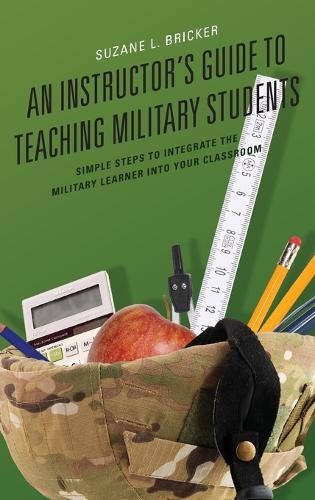
An Instructor's Guide to Teaching Military Students: Simple Steps to Integrate the Military Learner into Your Classroom
(Hardback)
Available Formats
Publishing Details
An Instructor's Guide to Teaching Military Students: Simple Steps to Integrate the Military Learner into Your Classroom
By (Author) Suzane Bricker
Bloomsbury Publishing PLC
Rowman & Littlefield Publishers
15th November 2017
United States
Classifications
Professional and Scholarly
Non Fiction
Higher education, tertiary education
Education / Educational sciences / Pedagogy
Educational administration and organization
378.1982835500973
Physical Properties
Hardback
172
Width 161mm, Height 237mm, Spine 18mm
390g
Description
An Instructors Guide to Teaching Military Students is a resource for online and on-ground educators in private and public learning institutions around the world. The content applies to faculty members in liberal arts and research-oriented institutions, and vocational trainers. Topics are related to the creation of lecture material and delivery of course content in computer and information science, engineering, and engineering technology, healthcare, business and finance, marketing communications and general education courses in the arts and social sciences. Suggestions on providing feedback that is sensitive to the unique culture and experiences of military students are provided as well. The last chapter includes the opinions of academic and military experts on what progress has been made in meeting the needs of this particular student population, as well as predictions about future changes that will facilitate the transition from service member to scholar. The term, military learners has been adapted for this text to include active-duty service members and their families, veterans, members of the U.S. National Guard, and reservists, as well as U.S. Department of Defense (DOD) contractors. Language used that can be easily understood and applied by the novice instructor, or the seasoned professional. This handbook also provides useful suggestions on helping students translate their military training and experience into more active classroom participation.
Reviews
Members of the military are often the most motivated students and bring leadership qualities and life experiences that are invaluable to the classroom. Suzane Brickers excellent and insightful handbook provides a window into military culture and practical steps to help instructors integrate active-duty service members and veterans into the classroom, address their unique challenges, and support them in reaching their full academic potential. -- Javier Miyares, president, University of Maryland University College
The Military Writers Society of America supports this project 100 percentand recommends this book to all undergraduate and graduate instructors. Suzane Bricker has successfullyopened a channel of communicationthat can lead to better academic success for individuals who have served, and continue to serve our country with honor. Her guidebookcombines the opinions of influential and concerned veteran advocates with insights from leading academic scholars. She is to be commended for her research into previously uncharted territory. -- Bill McDonald, Purple Heart Veteran, author, poet, international motivational speaker; founder, The Military Writers Society of America; film consultant, minister, veteran advocate
Having veterans in my classes is a privilege, a challenge, and, most of all, a responsibility. I have had to create my own training. I am thrilled to see, at last, such a thorough book to help all teachers and professors in this essential duty. -- Wick Sloane, administrator and adjunct professor of English, Bunker Hill Community College, Boston; Writes the column "The Devil's Workshop" for Inside Higher Ed
There are clear differences between traditional students and those who have spent time in the military. Suzane Bricker's handbook does an excellent job of highlighting these differences. Her book clearly informs the educator on how to have an impact on military learners. -- Daniel Fanella, PhD, Instructional Systems Specialist, United States Army War College
Author Bio
Suzane L. Bricker is an Associate Adjunct Online Professor at the University of Maryland University College (UMUC), and a peer editor for the Journal of Business and Technical Communication (JBTC).
